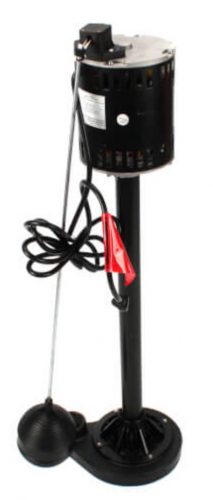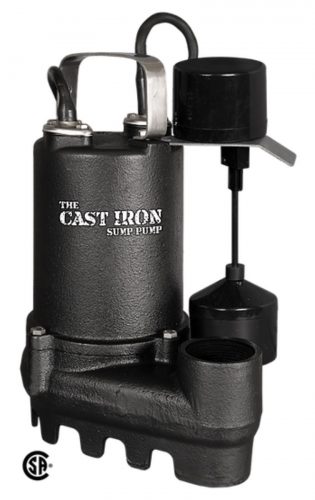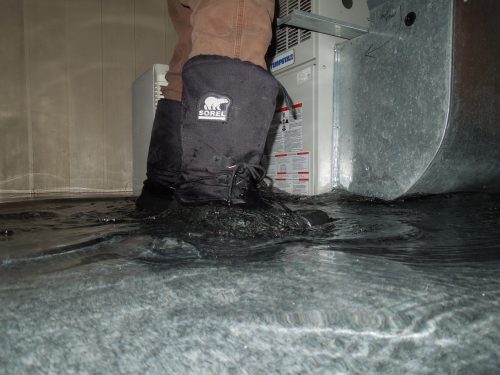This is a guest blog post by Steve Grohn, CEO of Standard Water Control Systems. We occasionally publish guest blog posts by invitation only.
Considering a new sump pump or backup system? Here’s what you need to know.
Your sump pump is the heart of your basement drain tile system, and if it fails, water is unable to exit your basement area. A power outage during a storm could literally cause hundreds of gallons of water to flood your basement. Not good.
There are essentially 5 decisions to make when considering what type of sump pump to purchase:
- Type of pump: submersible or pedestal
- Pumping capability
- Alarms, including wifi
- A backup pump or secondary system
- Warranty
Types
There are two types of sump pumps: submersible in water and non-submersible – which are also called Pedestal pumps. Pedestals were designed first, of course, because who would have thought to design a motor to actually operate underwater?
The Pedestal pump has several key features. First, since the pump sits above the basin, it is easier to inspect or observe because you don’t have to remove the pit lid and reach down in the water. The downside is that someone may bump into the exposed motor. Second, the impeller, which draws the water out, takes up less room so you can install it in smaller basins.

The submersible pump, on the other hand, runs much quieter as it is submerged in water with a lid on top that can be sealed. The lid should always be sealed to help prevent radon gas from entering the home, but that’s a topic for another blog. And since the pump is out of sight, there is little chance of damage or an accident. There are more submersible options on the market, as they are more popular. Finally, the submersible pump offers more pumping capacity for the price.

Pumping Capability
Horsepower doesn’t tell the whole story! Gallons pumped per minute (GPM) is the most effective way to measure pump performance. Some 1/3 HP models, for example, pump 20 GPM and others pump 50 GPM – both when measured at a vertical height of 10 feet. To determine your GPM needs, calculate out how much water is entering your sump pump basin per minute – then you know what size to buy. That being said, according to a manufacturer’s representative for one of the largest pump manufacturers in the United States, nearly all residential homes have 1/3 or 1/2 HP sump pumps. Consider calling a company specializing in drain tile and sump pumps for a professional opinion on proper sizing if need be.
Alarms, including Wifi
Why is an alarm or notification important? Because unless you plan to be in the basement when your pump is running you will NOT know when it fails. And if it does fail, your basement can possibly take on hundreds of gallons of water in a very short period of time. So consider an audible alarm, visual alarm, and even remote notifications in case of an emergency. Many models have wifi options to notify you through your smartphone.
Backup pump or redundancy
A backup pump or secondary system is an insurance policy against your primary pump either failing or losing power. A reliable secondary system in place is the best way to protect your property. True redundancy means a second pump, switch, source of power, discharge pipe and notifications should any of the redundant features be called on because of a primary pump failure, power interruption, frozen or separated pipe, or even a capacity shortfall on the initial pump in a major rainfall event. When considering backup options, make sure you find a system that is capable of pumping a sufficient amount. If you have a primary pump that can pump 40 GPM then you should have a backup pump that is capable of a similar amount. Why? You just might need that pump to save your basement during a major rainfall event when your power goes out. If you don’t have a generator, consider a maintenance-free versus a maintainable battery. While it may cost more, you don’t have to mess around monitoring or adding liquids.
Warranty
Almost all sump pumps come with a 1-, 2-, 3- or even 5-year warranty. Longer warranties normally accompany the better products, and thus, are usually more expensive. Some companies warrant pumps from the date of manufacturing, some from the date of purchase, and some from the date of installation. Some manufacturers ask to have the pumps returned and inspected (not returned to the stores) before those warranties are honored. Other companies back the installers to make those decisions on the spot. To get a labor warranty, you will typically need to hire a contractor, which again may cost more, but you also have peace of mind. Hiring a contractor who has experience with pumps can save you future headaches.
Stay tuned for the next article on drain tile – what you need to know when considering an updated or new drain tile system. If you’d like to learn more about sump pumps, or just need service, call us at 763-537-4849 or visit us online at StandardWater.com.
Related Structure Talk podcast: Basement Water

